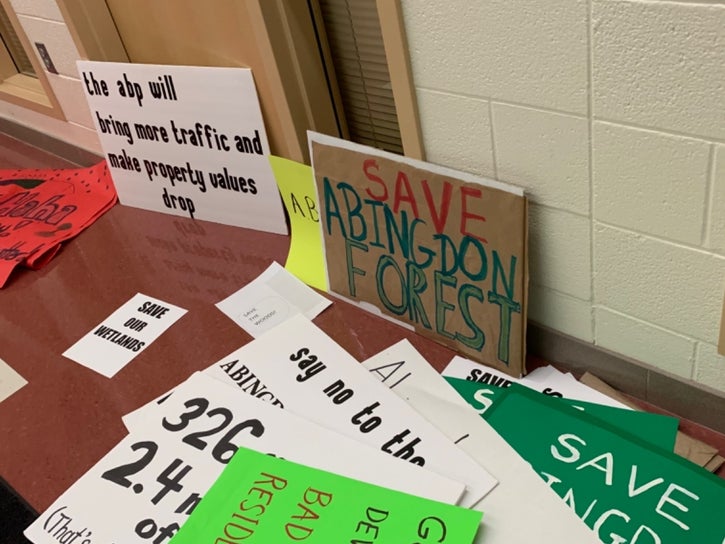
In Abingdon in Harford County, a developer has proposed to build a new "Abingdon Business Park:" three e-commerce/warehouse facilities, four restaurants, two flex retail spaces, one hotel, one convenience store and additional flex spaces, requiring the clear-cutting of 226 acres of a 330-acre forest. While sometimes development on forested lands is necessary, the developer has not proven that the negative externalities to the public are outweighed by the benefits, or that they considered putting their project on sites that would have less of an impact on water quality.
Read more about the proposal and community opposition to it on Patch here, read our testimony below, and stay tuned about updates for this development.

December 11, 2019
Louis Parnes
Nontidal Wetlands Division
Maryland Department of the Environment
1800 Washington Blvd.
Baltimore, MD 21230
Re: 201961268/19-NT-0228 - CREG/ WESTPORT I, LLC – Abingdon Business Park, Joint Federal/State Application for the Alteration of Any Floodplain, Waterway, Tidal, or Nontidal Wetland in Maryland
Dear. Mr. Parnes,
Clean Water Action is appreciative of this opportunity to comment on 201961268/19-NT-0228. Clean Water Action is a grassroots advocacy group with a direct focus on water quality. We have approximately 50,000 members throughout Maryland.
We have very strong concerns about this proposal, specifically on the impact it will, if constructed, have on waterways that have no additional assimilitive capacity and waterways that are already impaired.
The proposed site includes construction and installation of impervious surfaces within the catchment area of a tier II stream. Forested land is one of the best land uses to protect and preserve water quality. Replacing this forested land with impervious surface will have negative impacts on a tier II stream, and insufficient justification has been provided. The tier II stream in question, Otter Point Creek I, is judged to have no additional assimilative capacity, and any additional pollutant load is expected to lead to degradation.
State and federal regulations prioritize the maintenance of tier II status unless sufficient justification has been made to reclassify the stream. The applicant should complete an economic and market analysis to justify its need for large warehouse space in this area and identify why non-forested sites were not sufficient.
Furthermore, the Bush River watershed is impaired, and deforestation will add onto this impairment. Polluted runoff from development is a significant problem, and moving from forested land to impervious surface will further degrade the watershed. Again, the applicant has failed to provide justification for adding to this impairment and has failed to demonstrate how they will mitigate the damage proposed by deforesting this parcel.
As MDE’s “Nontidal Wetlands and their Values” states, “The health of the Chesapeake Bay ecosystem is inextricably linked to the abundance and condition of the wetlands in the bay watershed.” As Maryland and our neighboring states are working to protect and improve the Chesapeake Bay, damaging nontidal wetlands without sufficient cause is counterproductive to this goal. Additionally, a recent study completed for the United Nations Forum on Forests estimates that forests forests “absorb and store about 30% of current levels of carbon emissions from fossil fuels and industry into their biomass, soils and wood products, and have the potential to store much more. At present, however, about 12% of global greenhouse gas emissions are estimated to derive from deforestation, a process which is itself made more acute by the impacts of climate change. Forests can also help communities adapt to the impacts of climate change, stabilising and cooling local climates, including water flow and rainfall.” As the climate crisis worsens and climate mitigation and adaptation become more and more urgent, we must protect forested lands as part of climate action.
Forests play major roles in carbon sequestration and water quality, and as Maryland pursues both climate change mitigation and the Chesapeake Bay cleanup, allowing a project like this that deforest large parcels of forest is contrary to Maryland’s goals. If this project supported critical needs for the Harford County area, mitigation of the damages could be pursued, but as it stands the applicant has provided insufficient justification to pave over existing forest and has provided insufficient analysis to demonstrate that they considered alternate sites that may have had less of a negative impact on local and regional water quality.
We appreciate the opportunity to submit these comments with our concerns about this proposed project.
Thank you,
Emily Ranson
Maryland Program Coordinator
Clean Water Action


